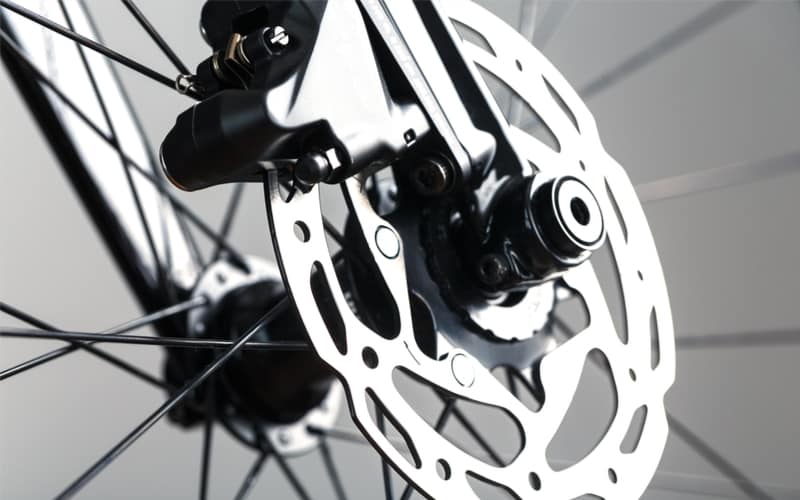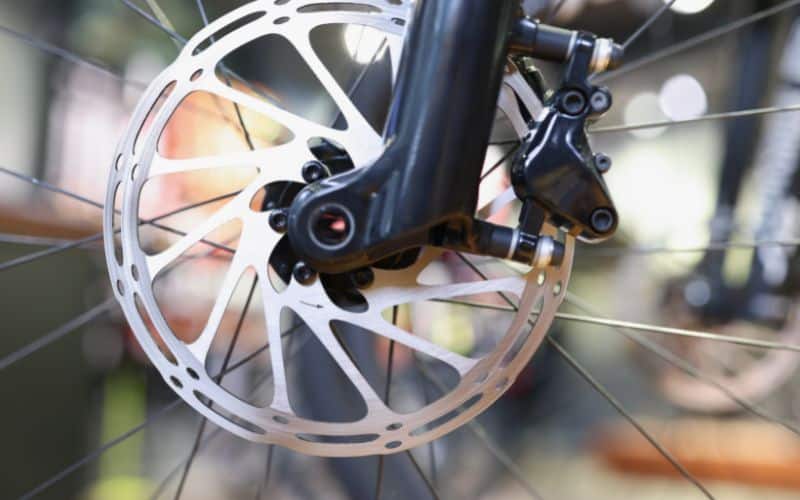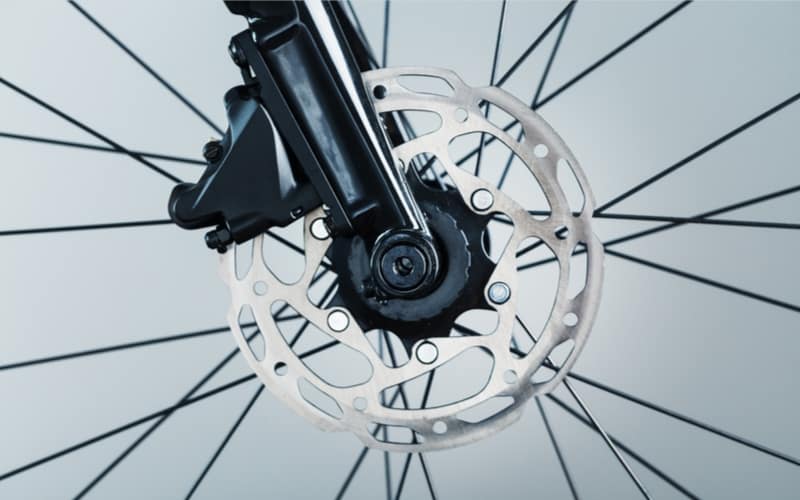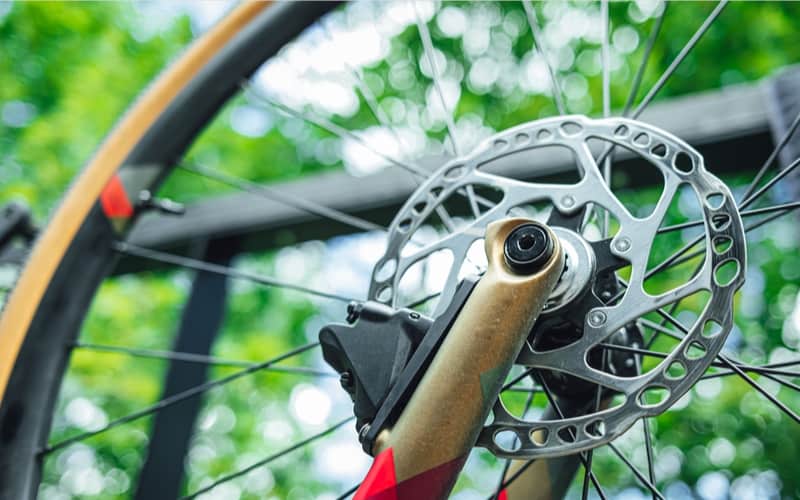Strong and reliable rotors are key to any mountain bike, especially if you frequently take it on arduous excursions.
You’ve heard of rotors snapping, bending, and breaking, and the last thing you want is for that to happen to you. So, you’re taking extra precautions to ensure your rotor is in the best condition possible.
But, does that mean you should frequently replace it? How long do MTB rotors usually last and how do you know when they need to be replaced?
Keep reading to find out!
Contents
How Long Will MTB Rotors Normally Last?

MTB rotors usually last between two to five years.
It’s difficult to accurately assess how long all rotors will last since their lifespan is drastically affected by the type of cycling you do and how often you do it, as well as your braking patterns.
Most MTB rotors will last between two to five years, or from 30,000 to 70,000 miles.
If you take bimonthly rides on pretty even terrain, you may never have to think about your rotor. However, if you go on intense bike rides through steep and rocky mountains, you should regularly check your rotor for wear and tear.
Dragging your disc brakes will not only lead to your brakes overheating, but also wear down your rotors, meaning you’ll have to replace them more frequently.
Other factors like rust and glazing (when the disc brake pads melt onto the rotor) could also force you to replace your rotors sooner.
How To Know if My MTB Rotors Need To Be Replaced?

There are a few ways you can tell if your MTB rotors need to be replaced.
We know that rotors can last up to a few years, but that their lifespan is mostly dependent on how you use your bike.
So, to avoid your rotor spontaneously snapping, it’s best to keep an eye on them and rely on your own judgment to know when it’s time to replace them.
Let’s learn what signs of wear and tear to look for on your rotors.
The Thickness has Decreased
One of the most precise ways of knowing if your rotors are in need of replacement is by measuring their thickness.
All rotors have their minimum thickness engraved into the metal. This value will tell you the thinnest your rotor can be without posing a safety hazard.
Because rotors are so thin and the minimum thickness is very precise, the only way to measure them is by using a vernier caliper, like the Qfun Stainless Steel Vernier Digital Caliper .

We suggest only purchasing digital vernier calipers as they’re more accurate than their non-digital counterparts.
If you don’t own a vernier caliper and don’t want to purchase one, you can head to your local bike shop and ask them to measure your rotors for you.
If the rotors are below the minimum thickness, you must replace your rotors and we suggest avoiding riding your bike until you’ve done so.
Watch the video below to learn how to accurately measure your rotors’ thickness and assess any wear.
It’s Worn Down
If you can’t get your hands on a vernier caliper, you can assess if your rotors need to be replaced by feeling if it’s been worn down by the brake pads.
Run your finger from the top of the rotor to the bottom where it comes in contact with the bike. If you feel like the rotor’s surface is concave instead of flat, then it’s time to order a replacement.
Sometimes, you may feel that the rotor’s edges are curved, creating a lip.
In more severe cases, you will be able to clearly see where the brake pads have come in contact with it.
If left unattended, your rotor could become dangerously thin (if it hasn’t already snapped), making it difficult for your brake pads to compress, putting you at risk of crashing.

It’s Been Bent
Did you recently crash your bike? Do your disc brakes and rotor regularly overheat?
If so, your rotor may have been bent.
Because rotors are so thin, you may not immediately recognize it’s been twisted.
This could make it difficult for your brake pads to come in contact with your rotor, which could prevent you from braking.
Although there are ways to fix your bent rotor by bending them back in place using your hands or a wrench, you must be careful not to break it.
Rotors are extremely thin, and manipulating the metal by bending it back and forth could weaken it, leading them to snap mid-ride or the next time you brake.
So, to ensure your rotor remains in good condition, it’s better to replace it instead of trying to bend it back into place yourself, possibly damaging it further.
It’s Been Cracked
Rotors tend to crack when exposed to extreme heat or from excessive braking and cycling.
This is more common for cross-drilled rotors since all of the rotor’s holes weaken it, making it more prone to cracks and breaks.
In extreme cases, the cracks can be deep enough to break the rotor in two. So, it’s crucial you replace your rotor as soon as you notice cracks beginning to form.
The cracks will only worsen and it’s virtually impossible to fix them without damaging the rotor.
How Often Should I Replace MTB Rotors?

You should replace your MTB rotors every two to five years, depending on your cycling habits.
It’s a good idea to check your rotors regularly, especially if you’re a competitive mountain biker.
While rotors should usually last two to five years, you may have to replace them more frequently.
If you’re not an experienced mountain biker, we recommend taking your MTB to a bike shop every few months to have them check the condition of your rotors, wheels, brake pads, etc.
It’s always better to be safe than sorry and never risk riding with a damaging rotor.
Remember, using disc brakes on a damaged rotor could be catastrophic, especially when mountain biking. So, take care and check your bike parts often.
3 Good MTB Rotor Brands
Let’s go over three solid rotor brands.
Choosing a rotor can be challenging.
Are you looking for one that encourages heat dissipation or one that is durable enough to last for years on end? Do you just want a rotor that adds some extra bling to your ride?
And with so many rotor brands out there, finding one that’s reliable and high-quality can be tasking.
Luckily, we’ve done the work for you.
Shimano

It’s no surprise that Shimano is one of the most well-respected rotor brands out there.
Several of their rotors use “Ice Technology” which helps to prevent overheating by incorporating aluminum and an aerodynamic design into their products.
Quite a few of their rotors have an impressive five stars on Amazon, and they’re a favorite of many MTB junkies.
SRAM

Up next on our list is SRAM for their sturdy rotors specifically designed for mountain biking. Like Shimano, they also use aluminum to prevent overheating in their 2-piece centerline rotors.
All of their rotors are extremely lightweight, with the most durable ones coming in at a mere 150 grams. This means they ensure a strong braking power and are long-lasting without weighing your bike down.
They have a wide range of styles, each designed with a specific purpose in mind, so you’re sure to find something that fits your exact needs.
Hope

Hope has several rotor designs, including 100% stainless steel pieces and floating rotors with an aluminum centerpiece.
One great thing about Hope rotors is that they come in a variety of colors, so you can customize your bike for an optimal riding experience and make it stylish at the same time.
These fashionable rotors are also less prone to bending, making them extremely durable.
Wrapping Things Up
You should be replacing your rotors every couple of years, but check them every few weeks or months, especially if you’re an avid biker.
When checking your rotors, measure the thickness, see if it’s worn or bent, and check for cracks.
Remember that the best way to fix a broken rotor is to replace it. So, please avoid trying to fix it yourself in an attempt to save money. Riding and braking with a broken rotor can be extremely dangerous.
If you’re in the market for a new rotor, check out Shimano, SRAM, or Hope for all your rotor needs.
Did you know how often you should replace your MTB rotors? What’s your favorite MTB rotor brand?
Let us know in the comments below!
